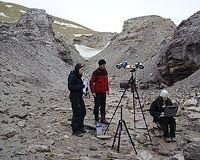 |
Bethesda MD (SPX) Oct 27, 2009 In response to a Launchspace request for comments, we have a guest commentary by Phil Henderson, Space Systems Engineer, Palm Bay, Florida: Exploration of Mars is a worthy goal, but it should not be the only goal. In fact, it alone could become like Kennedy's original moon goal and once completed, it becomes "been there, done that". A more worthy goal might be: To establish one or more self-sustaining, permanent space colonies, e.g., Mars or planetary moons, including ours. Along the way we can: - Explore and exploit solar system's smaller planets, asteroids and comets. - Look for evidence of life beyond earth. We should not underestimate the difficulty of even a "simple" Mars mission (especially for a country that agonized over the risk of sending astronauts to a high orbit to repair Hubble). Here are some steps along the way: 1. Return NASA to the primary goal of space exploration. Take NASA out of the LEO space transportation business and encourage multiple, competitive commercial solutions. 2. Develop key space travel technologies specifically for long duration missions. For example: - Radiation protection. - Gravity simulation. - Closed ecosystem for food, water and air. - Repairable and maintainable spacecraft systems. On Earth this would be called "Appropriate Technology for Village-Level Sustainability" (If we cannot keep our space station toilets going, how are we going to colonize Mars?). - Human factor design for long isolation periods. - Advanced propulsion systems with nuclear power generation (VASMIR) that enable significantly faster trips not limited to solar power. - In-situ processing (water production, mining, etc.). - Space robotics to handle the more dangerous or tedious tasks. 3. Perform a series of low-gravity missions with increasing durations to build confidence and experience. - Visit multiple near-Earth asteroids to prospect for water and high value materials, and to learn what technologies might be needed if we need to deflect one someday. 4. Develop a reusable, maintainable lander (cargo ship) for use on the Moon, Mars or other similar sized bodies, e.g., for the moons of Jupiter. Test it on the moon. Don't design something just for the moon that is not reusable. 5. Develop and demonstrate fuel and water making capability in both carbon dioxide and methane-based atmospheres using robotic missions first. Then, incorporate the technology as options on the reusable lander. 6. Plan a series of Mars missions with the capability for each to stay and explore for long durations, e.g., six months to one year each. 7. Develop technologies for permanent colonization in space. - Establish a base first, then a colony on a small asteroid having a water source. - Mine ore from an asteroid and create building materials for space habitats. - Demonstrate sustainable industrial processes in space, later to be applied to habitats on Mars or anywhere else of interest. - Establish a base, then a colony, on Mars. - Establish outposts or long duration exploration stations traveling throughout the solar system. It doesn't really matter how long it takes as long as the vision is maintained and we have incremental successes toward the ultimate goal- to become a species that thrives in more than one place in the universe. Share This Article With Planet Earth
Related Links Launchspace Space Tourism, Space Transport and Space Exploration News
 Building An Astrobiology Tool Kit
Building An Astrobiology Tool KitMoffett Field CA (SPX) Oct 21, 2009 How can we be sure that instruments that will be sent on future Martian missions will work properly? How do we know that they will obtain accurate and precise measurements? How will we be able to compare the data to what we have seen on our planet? The answer is easy: by testing, testing and again testing them during field trips on Earth. This has been one of the most important goals of ... read more |
|
| The content herein, unless otherwise known to be public domain, are Copyright 1995-2009 - SpaceDaily. AFP and UPI Wire Stories are copyright Agence France-Presse and United Press International. ESA Portal Reports are copyright European Space Agency. All NASA sourced material is public domain. Additional copyrights may apply in whole or part to other bona fide parties. Advertising does not imply endorsement,agreement or approval of any opinions, statements or information provided by SpaceDaily on any Web page published or hosted by SpaceDaily. Privacy Statement |